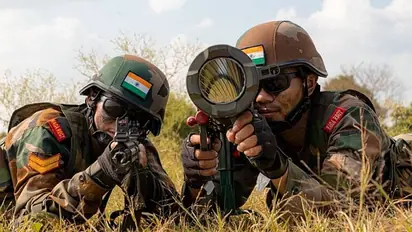Thwarting Chinese designs on 'Chicken Neck'

Synopsis
Asianet Newsable's Anish Kumar, who recently travelled to the Line of Actual Control, explains how the Indian Army is safeguarding the Siliguri corridor in West Bengal.
India is looking at alternate ways to mitigate the threats to the 20-km narrow Siliguri Corridor in West Bengal. As per reports, the Chinese have been strengthening its border infrastructure and now it has enhanced its connectivity in the depth areas in Chumbi Valley, which is close to Siliguri on the Indian side.
Also called 'Chicken neck', the Siliguri corridor is a stretch of land bordering Bhutan, Bangladesh and Nepal, measuring about 170X60km and at the narrowest, it is about 20-22 kilometres. The corridor assumes geostrategic significance considering that it connects northeast India to the rest of the country by way of national highways, railway lines and pipelines and optical fibre cable connectivity.
As per the experts, the corridor has always been on the radar of the Chinese war plans. In a conflict situation, if the Chinese block the corridor and cut off the northeast from the rest of the country, three primary military formations and their units will be cut off from equipment and weapons supply and reinforcements
To mitigate those threats, India has started taking several steps in beefing up security and defence of the vulnerable Siliguri corridor. Talking to media persons in Tenga recently, Eastern Army Commander Lt Gen Manoj Pande said, "We are looking at a whole of nation approach, which not includes the armed forces, but also the administrations of states around the Siliguri corridor and central agencies. The effort is to work together to deal with this threat in normal times along with the hybrid threat when it manifests and during conflict conditions."
He further said that a joint coordinating centre under the Army has proved to be effective to coordinate the actions of all agencies that work in the region. Nationally, the line of thought is to explore alternate means to mitigate the threats to Siliguri Corridor, the Army Commander said.
Also Read: China switches off BeiDou navigation system along India border
During the Doklam standoff in 2017, the Chinese tried to construct roads in Bhutanese territory, which would be very close to the Siliguri corridor but was objected to by the Indian troops. The standoff between Indian and Chinese troops went on for over 70 days. It ended only after Prime Minister Narendra Modi and Chinese President Xi Jinping had a telephonic conversation. The Chinese were trying to change the tri-junction to Gamochen but the attempts were thwarted by the Indian Army.
Pointing out the proximity of Chumbi Valley (in Tibet Autonomous Region) to the Siliguri corridor, Lt Gen Pande said the corridor not only has strategic importance but also has demographic dynamics.
"… there were different demographic groups who reside there and there were related challenges of radicalisation and separatist tendencies whose activities can be inimical to our security interest. The Siliguri corridor is sensitive to us," Lt Gen Pande added.
In a recent assessment report, the US Department of Defense said that the India-China standoff along the Line of Actual Control since the Galwan Valley clash in May 2022 has given the People's Liberation Army 'valuable real-world operational and tactical experience'.
The report -- 'Military and Security Developments Involving the People’s Republic of China' -- deep-dives into the ongoing tensions in Ladakh and Arunachal Pradesh. Highlighting the key developments of the Chinese military, the report claims that Beijing is taking 'incremental and tactical actions' to press its authority along the LAC.
According to the report, the acute tensions and clashes that followed along the Indo-China border also led to the PLA force buildup and the establishment of forwarding positions along the LAC. The report also points out that since early May 2020, personnel from both sides have indulged in 'multiple unarmed clashes' along the LAC.
It also mentions that village comprising of 101 houses built by China between Arunachal Pradesh and the Tibet Autonomous Region in the eastern sector sometime last year, clearly revealing Beijing's intention to stake a claim at the LAC despite the ongoing diplomatic and military dialogues.
Other dispatches from LAC
Meet Indian Army's precision deep strike options near China border
India's strategic tunnels near China border set for early completion
Indian Army personnel near LAC are studying Tibetans
Chinese wargaming near LAC has increased, but so has India's surveillance: Army
Indian Army raises new aviation brigade for LAC operations
How ALH Dhruv is saving lives in Eastern Sector (WATCH VIDEO)
Stay updated with the Breaking News Today and Latest News from across India and around the world. Get real-time updates, in-depth analysis, and comprehensive coverage of India News, World News, Indian Defence News, Kerala News, and Karnataka News. From politics to current affairs, follow every major story as it unfolds. Download the Asianet News Official App to stay informed anytime, anywhere.